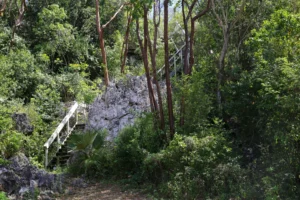Cayman: WE ARE NURTURED BY NATURE

Cayman’s Protected Areas Offer Sanctuary For Both Humans And Wildlife
As the tops of a deep-sea, underwater mountain range, the Cayman Islands evolved in isolation for millions of years. As animals and plants found their way across the sea to our shores they brought new life to the land which over time developed many unique and biodiverse ecosystems. As humans eventually passed through and began to settle our three small islands, learning how to live in, and with, the resources provided by this wild landscape became not only a means of survival but the Caymanian way of life.
Accessing Biodiversity
Today, like many islands in the region facing increasing populations, Cayman’s delicate ecosystems are vulnerable to habitat and biodiversity loss as land use expands into these previously untouched wild spaces.
To help advise government agencies and society in general on which species and habitats are most threatened and the conservation measures needed to ensure they thrive, the Government employs a diverse range of biologists and researchers, while sustainability specialists help inform how human activities can be modified to reduce adverse and often irreversible impacts.

As our islands urbanize, legally designated Terrestrial Protected Areas (TPAs) play a critical role in safeguarding our islands’ fragile ecosystems, but it’s the access they provide us to these wild spaces which offers an intrinsic value to human health and well-being that is as dynamic as it is far-reaching.
The endangered blue iguana only exists in Grand Cayman and no where else in the world.
Nurtured By Nature
Beyond the ecological benefits, access to expanses of nature provides people invaluable opportunities for improved overall health and mental well-being. Studies have shown that spending just a few minutes a day in green spaces improves physical health, reduces stress, and enhances cognitive function. In fact, the two major theories in this area of study are rooted in the concept that human health evolved to have an affinity for nature.
Attention Restoration Theory posits that the mental fatigue of modern life is associated with a depleted capacity to direct attention and that spending time in natural environments enables people to restore this capacity. Another perspective, Stress Reduction Theory explores how spending time in nature activates the parasympathetic nervous system to reduce stress because of people’s intrinsic connection to the natural world. A simple web search reveals an extensive amount of scientific support that humans are indeed nurtured by nature.
Wild Cayman
Wild spaces such as the Mastic Trail and Colliers Wilderness Reserve in Grand Cayman, the Parrot Sanctuary in Cayman Brac and Booby Pond Nature Reserve in Little Cayman, all protected and managed by the National Trust for the Cayman Islands. They allow both residents and visitors to disconnect from the bustle of modern life and become immersed in the sights and sounds of what our incredible Cayman Islands were like for the millions of years before human settlement.

Hemmington Forest in Cayman Brac is a Crown-owned protected area under the National Conservation Act which will soon have a management plan for public access. Sustainably designed and constructed walking trails and education stations will offer easy access to interior portions of the bluff top forest. This will enable elders, children and even wheelchairs to visit this pristine environment and enjoy its wildlife and natural beauty.

Cayman Parrots are endemic to the islands and rely on native trees for food and nesting.
Verdant Sanctuary
In many ways, protected areas are how we can preserve Cayman’s natural heritage, giving access to the abundance of natural life they harbour. By protecting threatened and endangered species, preserving fragile ecosystems, and promoting human health and well-being, these areas serve as vital components of a sustainable future. If we can strengthen conservation efforts and expand protected lands and seas, we will help ensure that the Cayman Islands remain a verdant sanctuary where generations to come may continue to be nurtured by Cayman’s deepest nature.

A hiker walks a bluff path in Cayman Brac.





